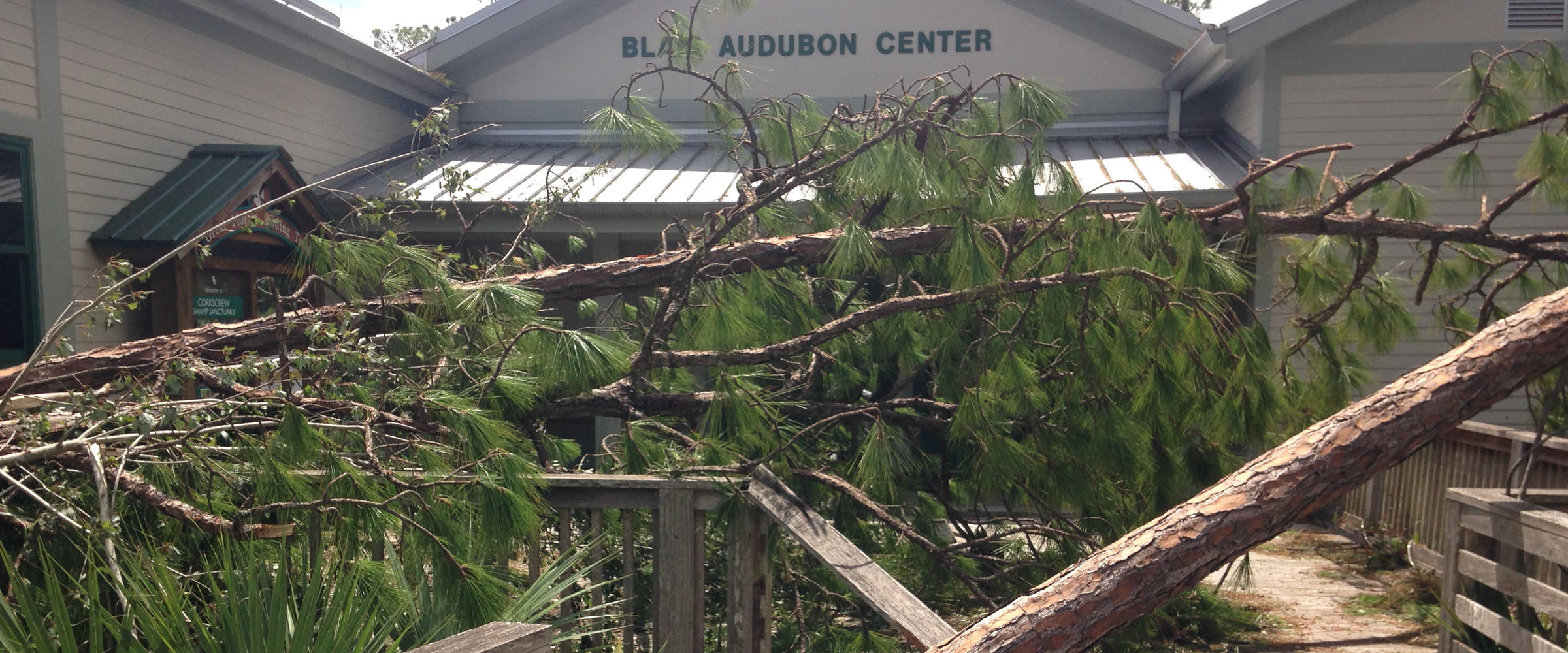Photo caption: the eye of Hurricane Irma brushed Audubon's Corkscrew Swamp Sanctuary on September 10 while staff and volunteers sheltered in the Blair Audubon Center. When they emerged, they found toppled trees making the center's entrance and boardwalk impassable. With help from dedicated staff, devoted volunteers and generous donors, the Sanctuary reopened part of its boardwalk on October 4, 2017 and celebrated its full reopening on December 7, 2017.
2017 brought extreme weather events that are making us all evaluate our role in and opportunities for Florida's recovery. For more than 100 years, Audubon has held complementary roles in Florida conservation:
- Organizing people in local science, education, and stewardship at our sanctuaries and centers and other special places and
- Using sound science to advocate for actions and resources to conserve, restore, and manage habitats. These interconnected roles work because our shoes on the ground, boats in the water, and scopes on bird nests give us a special understanding of the stresses on birds and wildlife.
These roles also oblige Audubon Florida’s board and staff to strategize responses to threats as varied as extreme weather
events, oil spills, invasive plants and animals, human population growth, and habitat alteration.
Increasingly frequent and intense storms and droughts threaten Florida's natural resources — we saw it firsthand in 2017 with Cindy, Irma, Harvey, Nate, the spring drought and wildfires and more.
Audubon’s goal for recovery from these events is to increase resilience while improving habitat values:
- To recover and make our sanctuaries and centers more resilient and
- To give habitat and wildlife and water management agencies the direction, authority, and funding they need to recover and restore natural systems and produce net habitat improvement.
The Challenges of 2017
Drought – Two-thirds of Florida experienced prolonged drought in 2017. Wildfires burned across the Big Cypress. Water restrictions were in place. Florida Bay lost thousands of acres of seagrass from lack of freshwater. Lake Okeechobee was drained to irrigate sugarcane farms, and Everglade Snail Kites did not nest in the spring.
Early wet season rainfall events – By mid-June, coastal areas were getting twice their usual rainfall, and by the end of June, Tropical Storm Cindy drowned thousands of shorebird nests at sites along the Gulf. A dry spring turned into a very wet summer as 30 inches of rain fell in America’s Everglades- drowning sensitive habitats and leading to an emergency as water was pumped into Lake Okeechobee and then harmfully dumped to coastal estuaries.
Harvey – Fifty inches of rainfall along with storm surges drowned major bird sanctuaries along the Texas coast, and even overwashed nesting colonies in the Florida Panhandle. Filled and over-drained wetlands contributed to the tragic flooding in Houston and other coastal cities. A lesson for similarly flat Florida.
King Tides – Seasonal high tides, known as king tides, inundated urban areas like Miami Beach and amplified the effects of storms, as evidenced by the major tide-driven flooding seen in Jacksonville after Hurricane Irma.
Irma – This powerful storm decimated the hardwood hammocks of the middle Keys on its way to plow into Southwest Florida. The shores of nesting islands in Florida Bay were blanketed in wrack, and erosion took its toll here as well as at nesting islands along the entire Southwest coast to Tampa Bay. University of Florida researchers found that more than 40 endangered Snail Kite nests were flooded out on Lake Okeechobee—a painful loss in an already poor breeding year. In Northeast Florida, dunes and beaches were washed away, toppling houses and prompting emergency armoring that will block this habitat from ever recovering. The storm plus high tides drove unprecedented flooding up the St. Johns River and into the heart of Jacksonville, providing a glimpse of the future of rising seas.
Audubon’s Road to Recovery and Resilience
It’s not enough to just recover from these events. We must use recovery to advance natural resiliency in the face of future challenges. Fortunately, Audubon’s strengths are well suited to this work—and we need your help:
Science and Public Policy Expertise
Audubon is influential when we come to the table with expertise about the science behind environmental challenges as well as environmental laws and rules and how they apply in specific conditions. Our knowledge makes us especially valuable to decision-makers and their staff.
Advocacy
Audubon’s strong volunteer leaders will be needed to use local examples to engage decision-makers at the community level, making issues real and relevant.
Influence
Influential board and chapter members help Audubon successfully advance solutions to the challenges facing our communities.




